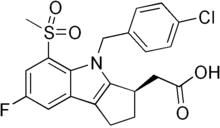m Spell increse => increase |
No edit summary |
||
| Line 49: | Line 49: | ||
Laropiprant acts as a DP<sub>1</sub> antagonist, reducing the vasodilation. |
Laropiprant acts as a DP<sub>1</sub> antagonist, reducing the vasodilation. |
||
Taking 650 mg of [[aspirin]] 20-30 minutes prior to taking niacin has also been proven to prevent flushing in 90% of patients, presumably by suppressing prostaglandin synthesis,<ref>[http://www.orthomolecular.org/library/jom/1976/pdf/1976-v05n02-p089.pdf The Action of Aspirin in Preventing the Niacin Flush and its Relevance to the Antischizophrenic Action of Megadose Niacin]</ref> but this medication increases the risk of [[gastrointestinal bleeding]] |
Taking 650 mg of [[aspirin]] 20-30 minutes prior to taking niacin has also been proven to prevent flushing in 90% of patients, presumably by suppressing prostaglandin synthesis,<ref>[http://www.orthomolecular.org/library/jom/1976/pdf/1976-v05n02-p089.pdf The Action of Aspirin in Preventing the Niacin Flush and its Relevance to the Antischizophrenic Action of Megadose Niacin]</ref> but this medication also increases the risk of [[gastrointestinal bleeding]],<ref name="H Toft">{{cite journal |author=Sørensen HT, Mellemkjaer L, Blot WJ, ''et al.'' |title=Risk of upper gastrointestinal bleeding associated with use of low-dose aspirin |journal=Am. J. Gastroenterol. |volume=95 |issue=9 |pages=2218–24 |year=2000 |month=September |pmid=11007221 |doi=10.1111/j.1572-0241.2000.02248.x |url=http://www.blackwell-synergy.com/openurl?genre=article&sid=nlm:pubmed&issn=0002-9270&date=2000&volume=95&issue=9&spage=2218}}</ref> though the increased risk is less than 1 percent. <ref>[http://news.yahoo.com/s/afp/20090831/hl_afp/healthresearchheartbritain ]</ref> |
||
==References== |
==References== |
||
Revision as of 17:26, 31 August 2009
 | |
| Clinical data | |
|---|---|
| License data | |
| Routes of administration | Oral |
| ATC code |
|
| Identifiers | |
| |
| CAS Number | |
| CompTox Dashboard (EPA) | |
| ECHA InfoCard | 100.207.712 |
| Chemical and physical data | |
| Formula | C21H19ClFNO4S |
| Molar mass | 435.90 g/mol g·mol−1 |
Laropiprant (pINN; codenamed MK-0524A) is tested in combination with niacin to reduce blood cholesterol (LDL and VLDL). This combination will be marketed by Merck & Co. under the tradenames Cordaptive and Tredaptive.
Laropiprant itself has no cholesterol lowering effect, but it reduces facial flushes induced by niacin. In a trial with 1613 patients, 10.2% patients stopped taking the medication in the Cordaptive group versus 22.2% under niacin monotherapy.[1]
Method of action
Niacin in cholesterol lowering doses (500-2000 mg per day) causes facial flushes by stimulating biosynthesis of prostaglandin D2, especially in the skin. PG D2 acts as a vasodilator via DP1 receptors, increasing blood flow and thus leading to flushes.
Laropiprant acts as a DP1 antagonist, reducing the vasodilation.
Taking 650 mg of aspirin 20-30 minutes prior to taking niacin has also been proven to prevent flushing in 90% of patients, presumably by suppressing prostaglandin synthesis,[2] but this medication also increases the risk of gastrointestinal bleeding,[3] though the increased risk is less than 1 percent. [4]
References
- ^
E Lai; et al. (2007). "Suppression of Niacin-induced Vasodilation with an Antagonist to Prostaglandin D2 Receptor Subtype 1". Clinical Pharmacology & Therapeutics. 81: 849–857. doi:10.1038/sj.clpt.6100180.
{{cite journal}}: Explicit use of et al. in:|author=(help) - ^ The Action of Aspirin in Preventing the Niacin Flush and its Relevance to the Antischizophrenic Action of Megadose Niacin
- ^ Sørensen HT, Mellemkjaer L, Blot WJ; et al. (2000). "Risk of upper gastrointestinal bleeding associated with use of low-dose aspirin". Am. J. Gastroenterol. 95 (9): 2218–24. doi:10.1111/j.1572-0241.2000.02248.x. PMID 11007221.
{{cite journal}}: Explicit use of et al. in:|author=(help); Unknown parameter|month=ignored (help)CS1 maint: multiple names: authors list (link) - ^ [1]